Starbucks Bundle
Decoding Starbucks: What Drives the Coffee Giant?
Ever wondered what fuels the global success of Starbucks? Beyond the aroma of freshly brewed coffee, lies a powerful framework of purpose and aspiration. This exploration delves into the Starbucks SWOT Analysis, examining the company's mission, vision, and core values.
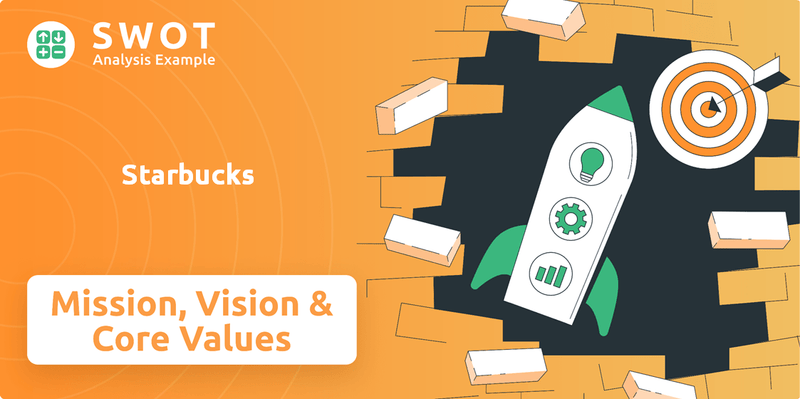
Understanding the Starbucks mission statement, Starbucks vision statement, and Starbucks core values is crucial to grasping its enduring appeal and strategic direction. This analysis will uncover how these principles shape everything from Starbucks company values to its commitment to ethical sourcing and long-term goals, providing valuable insights for investors and business strategists alike. Discover Starbucks' mission vision and values examples and how they are implemented.
Key Takeaways
- Starbucks' mission, vision, and values are central to its brand and global expansion.
- Focus on quality, connection, and responsibility has built strong customer loyalty.
- Adherence to these principles is vital for adapting to market changes.
- Starbucks aims to inspire and nurture through coffee and community.
- Corporate purpose drives both profitability and positive impact.
Mission: What is Starbucks Mission Statement?
Starbucks' mission is 'to inspire and nurture the human spirit – one person, one cup, and one neighborhood at a time.'
Let's delve into the core of Starbucks' identity: its mission. Understanding the Starbucks mission statement is crucial for grasping the company's strategic direction and its impact on the world. This statement is more than just words; it's a guiding principle that shapes every aspect of Starbucks' operations, from its product offerings to its community involvement.
At its heart, the Starbucks mission statement is a blend of two key elements: a dedication to providing the finest coffee and a commitment to fostering human connection. This dual focus underscores the company's understanding that it's not just selling coffee; it's selling an experience.
The mission statement clearly identifies the target customer as individuals within neighborhoods, emphasizing a community-centric approach. Starbucks' market scope is undeniably global, with over 38,000 stores worldwide as of late 2024, demonstrating its widespread presence and influence.
The unique value proposition lies in the emphasis on inspiring and nurturing the human spirit. This positions Starbucks as more than just a coffee shop, but as a place for connection, belonging, and a welcoming environment. This is a core component of the Starbucks company values.
Starbucks operationalizes its mission in various ways. They create a 'third place' between home and work in their stores, designed for comfort and community gathering. The focus on high-quality coffee is evident in their ethical sourcing practices, such as Coffee and Farmer Equity (C.A.F.E.) Practices.
The mission's emphasis on human connection is seen in the personalized customer service and the effort to create a welcoming environment in every store. Starbucks has invested heavily in ethical sourcing, with 99% of its coffee being ethically sourced. This commitment aligns with the Starbucks goals to be a responsible corporate citizen.
The mission is strongly customer-centric, aiming to create positive experiences and connections for individuals, while also having a significant social responsibility and community orientation. To further understand how Starbucks approaches its consumer base, you can explore the Marketing Strategy of Starbucks.
The Starbucks vision statement and its Starbucks core values are deeply intertwined with this mission, creating a cohesive framework that guides the company's actions and decisions. The mission statement serves as a constant reminder of what Starbucks strives to achieve, day in and day out.
Starbucks SWOT Analysis
- Complete SWOT Breakdown
- Fully Customizable
- Editable in Excel & Word
- Professional Formatting
- Investor-Ready Format
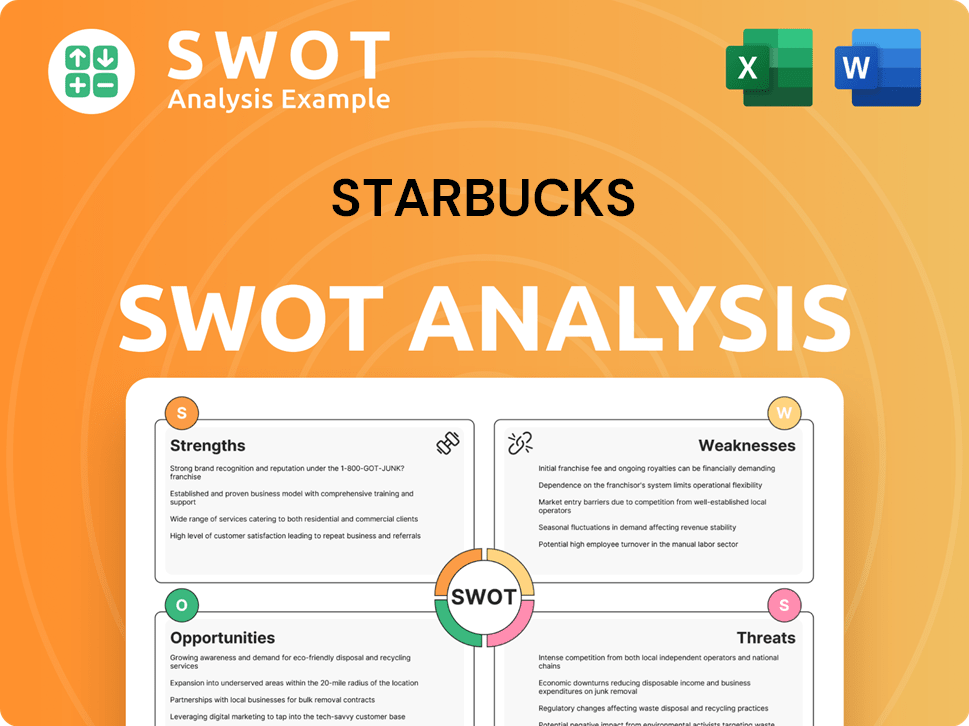
Vision: What is Starbucks Vision Statement?
While a formal, standalone "Starbucks vision statement" may not always be explicitly separated from its mission, the company's aspirations for the future are deeply embedded in its core values and strategic communications. Starbucks envisions a world where its business practices and products contribute positively to both people's lives and the planet.
Let's delve into Starbucks' vision.
Starbucks aims to be the premier purveyor of the finest coffee in the world. This signifies a clear vision of market leadership and a commitment to quality. The company strives to be recognized globally for its superior coffee, customer experience, and brand reputation.
The Starbucks vision is undeniably global, evidenced by its ongoing international expansion. The company has set ambitious goals for growth, including a target to reach 55,000 stores worldwide by 2030. This aggressive expansion strategy underscores Starbucks' long-term vision for the future and its commitment to increasing its global footprint.
A crucial element of Starbucks' vision is its commitment to sustainability. The company aims to be a leader in environmentally responsible practices, which is reflected in its ethical sourcing initiatives and efforts to reduce its environmental impact. This commitment is an integral part of the Starbucks mission statement.
Starbucks envisions itself at the forefront of innovation within the coffee industry. They strive to be more than just a coffee shop; they aim to be a hub for community and connection, fostering a welcoming environment for customers. This vision is supported by their investment in new technologies and customer experience improvements.
The Starbucks vision statement is realistic yet aspirational, building on its current market position and strong brand recognition. The company sets ambitious goals for growth and sustainability, demonstrating a commitment to long-term success. The company's ability to adapt and innovate is crucial to achieving these goals.
Starbucks' financial performance reflects its vision for growth. In fiscal year 2023, Starbucks reported record revenues. The company's commitment to its vision is further demonstrated by its investments in store renovations, new product development, and employee training. For more details, check out the Brief History of Starbucks.
The Starbucks vision statement, though not always explicitly separated, encompasses market leadership, global expansion, sustainability, innovation, and community engagement. These elements work together to define Starbucks' long-term goals and strategic direction. Understanding the Starbucks mission vision and values examples provides insight into the company's strategic approach.
Starbucks PESTLE Analysis
- Covers All 6 PESTLE Categories
- No Research Needed – Save Hours of Work
- Built by Experts, Trusted by Consultants
- Instant Download, Ready to Use
- 100% Editable, Fully Customizable
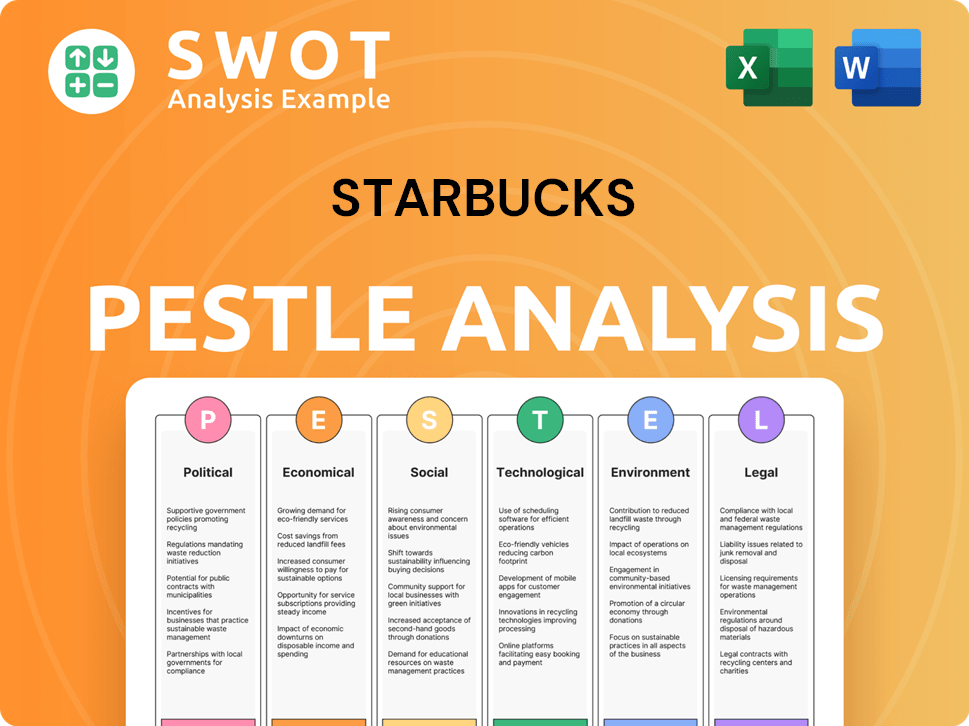
Values: What is Starbucks Core Values Statement?
Starbucks' core values are the bedrock of its identity, guiding its actions and shaping its culture. These values are not just words; they are the principles that drive every decision, from sourcing coffee beans to creating a welcoming environment for customers.
Craft at Starbucks signifies a dedication to quality and excellence. This value is evident in the meticulous sourcing of coffee beans, the roasting process, and the handcrafted beverages served. Starbucks invests heavily in training its baristas to ensure each drink meets its high standards, contributing to the overall 'Starbucks Experience'.
Results at Starbucks emphasize achieving goals with integrity and driving continuous innovation. The company focuses on growth and profitability, aiming to deliver returns to shareholders while constantly seeking new ways to improve efficiency. Starbucks' commitment to results is reflected in its financial performance; for example, in Q1 2024, global comparable store sales increased by 5% demonstrating their focus on business practices.
Belonging is central to Starbucks' identity, creating a welcoming and inclusive environment for everyone. This value is evident in the company's commitment to diversity, equity, and inclusion, fostering a sense of community in stores. Starbucks' efforts to create a sense of belonging are crucial to its brand identity and customer loyalty, with a recent study showing that customers who feel a sense of belonging are more likely to visit frequently.
Joy emphasizes taking pride in work, having fun, and celebrating achievements. This contributes to a positive corporate culture and aims to create enjoyable experiences for both employees and customers. Starbucks strives to create a positive atmosphere in its stores, which contributes to employee satisfaction and customer loyalty, as well as creating an enjoyable experience for all.
These Starbucks company values differentiate the brand by fostering a strong emotional connection with customers and partners, going beyond a purely transactional relationship. Understanding how these core values are implemented gives insight into the Starbucks mission statement and Starbucks vision statement. Next, we will explore how the mission and vision influence the company's strategic decisions.
How Mission & Vision Influence Starbucks Business?
Starbucks' mission and vision statements are not just words on a wall; they are the foundational pillars that guide the company's strategic decisions and actions. These statements directly influence every aspect of the business, from product development to global expansion, ensuring a cohesive and purpose-driven approach.
The "Back to Starbucks" strategy, initiated in early 2025, exemplifies the direct influence of the Starbucks mission statement and vision. This strategy aims to revitalize the brand by focusing on its core strengths: high-quality coffee, fostering human connection, and enhancing the in-store experience. This reflects a commitment to the Starbucks company values and a return to the essence of what made Starbucks successful.
- Re-emphasizing the in-store experience to combat declining sales in certain markets.
- Investing in barista training to improve coffee quality and customer service.
- Streamlining operations to improve efficiency and enhance customer satisfaction.
The Starbucks vision statement of being a premier purveyor of the finest coffee drives continuous innovation in product offerings. This includes the development of new coffee blends, seasonal beverages, and food items. Investments in barista training and quality control are direct results of this commitment.
The neighborhood focus of the Starbucks mission statement and the global aspirations of the vision fuel strategic decisions on market expansion. Starbucks aims to be conveniently available in diverse locations worldwide. As of 2024, Starbucks operates over 38,000 stores globally, with plans to reach 55,000 stores by 2030.
Collaborations and acquisitions are strategically aligned with the mission of providing coffee to people wherever they are. The partnership with Nestlé for "Starbucks at Home" products is a prime example, expanding the brand's reach beyond physical stores. This partnership has significantly boosted revenue, with the consumer packaged goods segment contributing a substantial portion of Starbucks' overall revenue.
Commitment to sustainability, a key component of the Starbucks core values, guides responses to environmental concerns. Starbucks has set ambitious goals for reducing carbon emissions, water usage, and waste. These initiatives include sourcing ethically and sustainably, reducing single-use plastics, and investing in renewable energy. The company's commitment to ethical sourcing and environmental responsibility is a core tenet of its Starbucks culture.
Starbucks' Starbucks goals to double Starbucks Rewards members and expand to 55,000 stores globally by 2030 reflect growth driven by the mission and vision. The company's financial performance, including revenue growth and profitability, is closely tied to its ability to execute its strategic initiatives. Starbucks' revenue in 2024 reached $36 billion, demonstrating its continued success.
Leadership plays a crucial role in reinforcing the mission, vision, and values. CEO Brian Niccol emphasizes a return to the core values of coffee, people, and humanity. This leadership focus helps shape day-to-day operations by emphasizing quality, customer connection, and a welcoming environment in stores. For more insights into Starbucks' strategic approach, consider exploring the Growth Strategy of Starbucks.
In essence, Starbucks' mission and vision are not static; they are dynamic forces that shape every aspect of the company's strategy and operations. The alignment between these statements and the company's actions is critical to its continued success and ability to adapt to evolving market conditions. Ready to delve deeper into how Starbucks is refining its guiding principles? Let's explore the next chapter: Core Improvements to Company's Mission and Vision.
Starbucks Business Model Canvas
- Complete 9-Block Business Model Canvas
- Effortlessly Communicate Your Business Strategy
- Investor-Ready BMC Format
- 100% Editable and Customizable
- Clear and Structured Layout
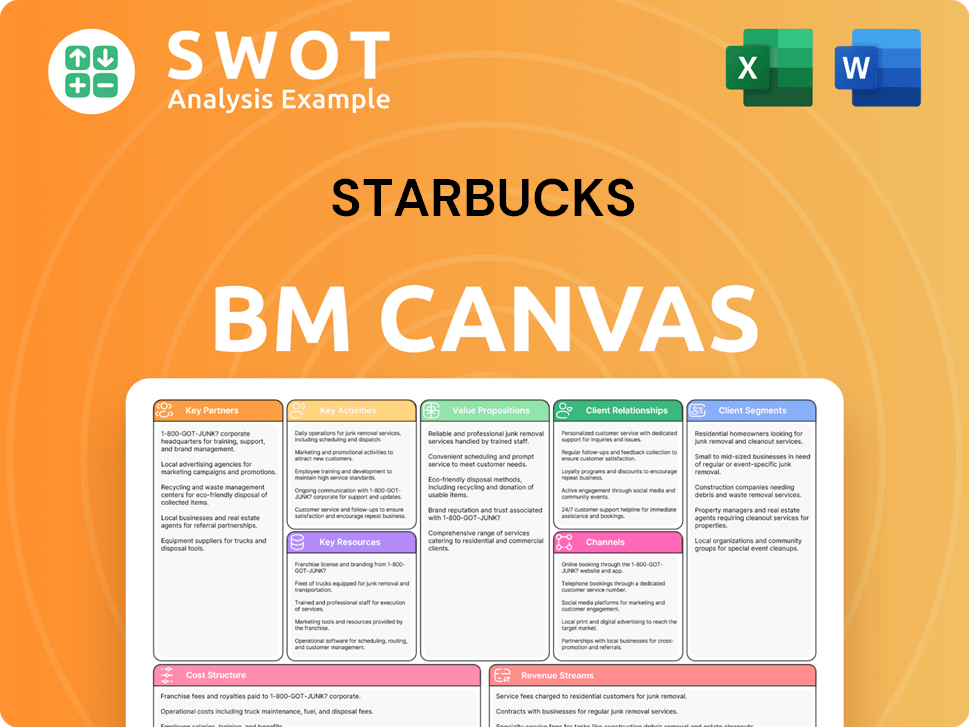
What Are Mission & Vision Improvements?
While Starbucks' mission, vision, and core values have been instrumental in its success, continuous improvement is essential in today's dynamic market. This section explores potential refinements to enhance Starbucks' alignment with current trends and solidify its position as an industry leader.
Starbucks could benefit from more explicitly stating its broader social impact within its mission, vision, or core values. This involves highlighting initiatives related to social equity, economic opportunity in coffee-growing regions, and support for local communities. This resonates with the growing number of consumers prioritizing ethical and socially responsible brands; according to a 2024 study, 77% of consumers are more likely to purchase from companies committed to social issues.
Formally embedding innovation and technological leadership within Starbucks' core statements is crucial. This reflects the increasing importance of digital transformation in the industry and signals a forward-looking approach to meeting changing consumer behaviors, such as the growth of mobile ordering and delivery; in 2024, mobile orders accounted for approximately 30% of Starbucks' total sales.
Ongoing scrutiny regarding Starbucks' supply chain and environmental impact necessitates continuous adaptation and potentially stronger commitments within its guiding principles. This could involve setting more ambitious sustainability targets and increasing transparency to address consumer concerns; for example, Starbucks could aim to reduce its carbon footprint by 50% by 2030, as some competitors have done.
Starbucks' vision statement could be refined to provide a clearer articulation of its long-term aspirations and strategic goals. This could involve defining a bold future aspiration distinct from its present mission, focusing on aspects such as global expansion, market leadership, and innovative product development. For more insights into the company’s financial standing and strategic direction, consider the perspective of Owners & Shareholders of Starbucks.
How Does Starbucks Implement Corporate Strategy?
Implementing a strong mission, vision, and set of core values is crucial for any company, and Starbucks is no exception. This chapter explores how Starbucks translates its stated principles into tangible actions and initiatives, shaping its business strategy and impacting its stakeholders.
Starbucks demonstrates its commitment to its mission and vision through a variety of operational strategies. These initiatives are designed to create a welcoming environment and foster human connection, reflecting the essence of the Starbucks mission statement.
- 'Third Place' Design: The physical design of Starbucks stores, aiming to be a 'third place' between home and work, directly implements the mission of creating a comfortable and inviting space for customers.
- Ethical Sourcing: Programs like C.A.F.E. Practices (Coffee and Farmer Equity) are a cornerstone of Starbucks' commitment to quality and social responsibility, aligning with its core values.
- Partner Investment: Significant investments in barista training, employee benefits, and career development programs highlight the value Starbucks places on its employees, or "partners," and their role in delivering the Starbucks Experience.
- Digital Initiatives: Starbucks has been investing heavily in digital initiatives, including its mobile app, to enhance customer experience and drive sales. In 2024, mobile orders accounted for a significant portion of total transactions, reflecting a shift towards convenience and personalized service.
Leadership plays a critical role in reinforcing Starbucks' mission, vision, and core values. Effective communication from the top down ensures that these principles are understood and embraced throughout the organization.
While Brian Niccol is not the CEO of Starbucks, the company's leadership is constantly evolving. Future strategies will likely re-center the company around its core mission and values, emphasizing coffee quality and human connection. Leaders communicate the importance of these principles through internal communications, training programs, and by embodying the values in their own actions.
Starbucks utilizes various channels to communicate its values, including internal newsletters, training programs, and regular meetings. These platforms reinforce the importance of the Starbucks mission and vision statement and how it translates into daily operations.
Leaders at Starbucks are expected to model the company's core values in their behavior and decision-making. This includes fostering a culture of respect, inclusivity, and ethical conduct, which is crucial for building a strong brand and employee loyalty.
Starbucks strives to align its actions with its stated values, though challenges and criticisms inevitably arise. The company's commitment to sustainability and ethical practices is constantly evolving.
- Environmental Goals: Starbucks has set ambitious environmental goals, including reducing carbon emissions, water usage, and waste. The company aims to have 10,000 'Greener Stores' by 2025, demonstrating its commitment to sustainability.
- Reusable Cup Initiatives: Starbucks has implemented programs to encourage the use of reusable cups, aiming to reduce waste. In 2024, the company expanded its reusable cup program in several markets, with the goal of increasing customer participation.
- Supply Chain and Packaging: Starbucks faces ongoing challenges related to the environmental impact of its packaging and supply chain. Addressing these issues is crucial for maintaining alignment between its values and practices.
- Formal Programs and Systems: Starbucks utilizes formal programs and systems, including partner training and development programs and sustainability reporting, to ensure alignment with its mission and vision.
- Ethical Sourcing and Community Impact: Starbucks' commitment to ethical sourcing, through programs like C.A.F.E. Practices, aims to ensure fair treatment of coffee farmers and promote sustainable farming practices. The company also invests in community initiatives, reflecting its desire to make a positive impact on the world.
Starbucks utilizes various methods to measure and report on its progress towards its goals, including sustainability reports and regular performance reviews. This transparency helps the company stay accountable and identify areas for improvement.
Starbucks actively seeks feedback from its partners (employees) to understand their experiences and identify areas where the company can better live up to its values. Employee surveys and open communication channels are essential for fostering a culture of continuous improvement.
Starbucks recognizes that implementing its mission, vision, and core values is an ongoing process. The company is committed to continuous improvement, adapting its strategies and initiatives based on feedback, data, and evolving societal expectations. Understanding the Competitors Landscape of Starbucks is also crucial for adapting and staying ahead.
Starbucks Porter's Five Forces Analysis
- Covers All 5 Competitive Forces in Detail
- Structured for Consultants, Students, and Founders
- 100% Editable in Microsoft Word & Excel
- Instant Digital Download – Use Immediately
- Compatible with Mac & PC – Fully Unlocked
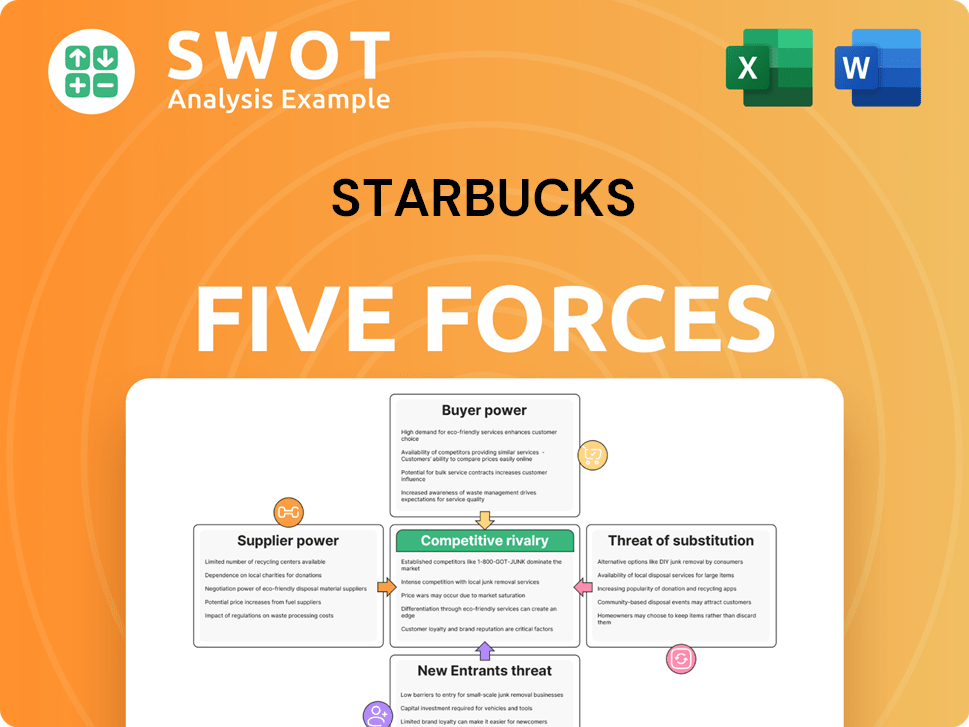
Related Blogs
- What are Mission Vision & Core Values of Starbucks Company?
- What is Competitive Landscape of Starbucks Company?
- What is Growth Strategy and Future Prospects of Starbucks Company?
- How Does Starbucks Company Work?
- What is Sales and Marketing Strategy of Starbucks Company?
- Who Owns Starbucks Company?
- What is Customer Demographics and Target Market of Starbucks Company?
Disclaimer
All information, articles, and product details provided on this website are for general informational and educational purposes only. We do not claim any ownership over, nor do we intend to infringe upon, any trademarks, copyrights, logos, brand names, or other intellectual property mentioned or depicted on this site. Such intellectual property remains the property of its respective owners, and any references here are made solely for identification or informational purposes, without implying any affiliation, endorsement, or partnership.
We make no representations or warranties, express or implied, regarding the accuracy, completeness, or suitability of any content or products presented. Nothing on this website should be construed as legal, tax, investment, financial, medical, or other professional advice. In addition, no part of this site—including articles or product references—constitutes a solicitation, recommendation, endorsement, advertisement, or offer to buy or sell any securities, franchises, or other financial instruments, particularly in jurisdictions where such activity would be unlawful.
All content is of a general nature and may not address the specific circumstances of any individual or entity. It is not a substitute for professional advice or services. Any actions you take based on the information provided here are strictly at your own risk. You accept full responsibility for any decisions or outcomes arising from your use of this website and agree to release us from any liability in connection with your use of, or reliance upon, the content or products found herein.